Viking and Medieval Nålebinding Mitten Replicas
Based on archaeological finds from Finland
© Satu Hovi 2003 / 2017
This article and the replicas were created for a competition of medieval crafts in 2002. This is a documentation of the process of making these replicas. Yes, I got a first price!
No part of this text is allowed to be cited or published without my permission. Please note that methods of research get better all the time, and new interpretations may appear.
The aim of this study is to investigate the different techniques and qualities of yarn used in nålebinding in Finnish Viking Age and Medieval finds. Many people do nålebinding using only natural grey, thick yarn and simplest technique, but did they do so in the Viking Age? No, they did not, I can say now.
I had a whole bunch of different yarns and I wanted to find out whether I could use them in this project, though they were bought from a mundane store and not spun by myself from wool of an ancient sheep. I was surprised by the results, noticing the wide variety of yarns in a quality similar to that used in the medieval times: many of the yarns I had were close to ancient ones. It helped that the methods of Z-spinning and S-plying used nowadays for manufacturing yarns in Finland were already the most common methods in Iron Age Finland (Vajanto, conversation). Sheep species were different from the most common breeds used nowadays, but still a mundane manufacturers are able to make products close to ancient ones, which surprised me. The length, strength and the quality of wool is not alike today. Plying angle is different, and nowadays' spinning mills demand that sheep are cut 2 or 3 times a year, otherwise the spinning machines will break. In ancient times the sheep were cut once a year; this could be done by hand, and the wool structure stayed unbroken. The only way to have yarn with similar quality would be to have one's own sheep and do the shearing and spinning myself. (Vajanto, 17.4.2003)
Another interesting observation I made during this study was that there is a heavy suspicion that there are many mistakes to be found in the articles which historians and archeologists have writen about nålebinding and its construction. The reality might be different, if the surviving pieces were able to be closely observed in the museum cellars. The problem with this is that an ordinary person is not allowed to touch those historical pieces without appropriate credentials or proper controls and supervision; even then there are many closed doors. I was pleased to be able to get some information and to consult with Mrs.. Krista Vajanto, who is working on her archaeology undergraduate degree at the University of Helsinki about nålebinding mittens in Luistari cemetery in Eura, west coast Finland.
The quality of current laboratory equipment also changes older information; for example the Swedish Åsle a mitten, which was originally dated 200 AD, was recently investigated with a C-14 dating and found to be made in late 16th-early 17th century (Nockert, p. 65).
Nålebinding - the method
Nålebinding, or looped needle netting, to sew mittens, is a method where the loops are attached to each other with a needle form a knit like construction, which is not as stretchy as modern knitting is. The method is much simpler and older than knitting (Hald). It is also my opinion that the Finnish verb 'neuloa', to knit, comes from the words 'neula', a needle, and was first used for nålebinding, which is made with a needle, and then just transferred to the new method of knitting.
In Finland nålebinding is and was made with more loops on the thumb than in the rest of Scandinavia. In Scandinavia they made nålebinding using just one loop in the thumb (Hald), whereas Vahter, Kaukonen and Vajanto agree that in Finland they used from two to as many as four loops on the thumb. That makes the lines higher, but it is also slower to complete. The most likely commonly used method in the Iron Age and in medieval Finland was the two loops in the thumb- method. In Egon Hansen's language that means: UUOO/UUOOO.
History of nålebinding in Finland
Nålebinding was in use in Finland until 19th century. Mittens, socks and hats were all produced using nålebinding (Lehtosalo-Hilander, Euran puku ja muut muinaisvaatteet). So far the Finnish finds are all mittens, based on the position of the leftover pieces in the graves. Toini-Inkeri Kaukonen's research indicates that modern knitting became known in Scandinavia first in Iceland during the 16th century, and at first it was used to make silk socks for the high society. According to the justice books modern knitting became known in Finland in the 17th century, about the same time as in Denmark, Sweden, Estonia and Lithuania. Many historians write that the nuns in the cloister of Nådendal, near Turku, were the first to do modern knitting, but based on surviving Finnish medieval files that is an error. Mrs. Kaukonen writes that in the text where it is written that Duke John, son of the Swedish king Gustaf Vasa, from the castle of Turku (he ruled the castle in 1550-1570's) did order the nuns of the Nådendal cloister to make him some mittens 'made in the common method of the country', 'the common method' means nålebinding, which differs from the opinion of many other professors. In the books of the castle of Turku from 16th century there are some silk socks, but according to Pylkkänen they all were imports from Europe. (Kaukonen, Kotiteollisuus)
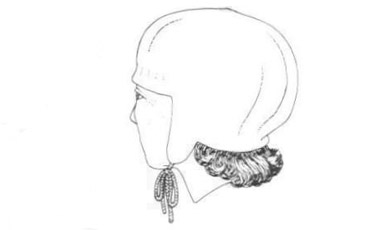
Knitted mitten from 16th century Iceland
Mrs. Mari Vadén has investigated some medieval textiles found in Turku now held in Turku county museum. According to her some of the surviving textiles were knit. The biggest piece (20459/864) is about 27 cm x 6,5 cm, plain knit, reddish brown in color with a dark thin line on 7th row, Z-spun S-plaid yarn. It has 1,7 loops and 3 lines per centimeter. It was dated between 1440-1550. She compares this piece to ones that are found in London (Crowfoot) and finds that they resemble each other very much. The London pieces were from a cap with ear flaps. She very strongly considers this to be a confirmation that people in Finland could knit already in those days (Vadén, p. 11-12).
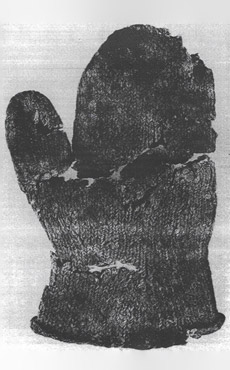
(Torsteisson, p.164)
Knitted hat from medieval London excavations. Crowfoot, p.56.
I would not make any decisions based on just one find; in my opinion we need more information and/ or more samples. I find it more likely that these pieces were an import from England, or left by an Englishman or other European visitor in Turku. Unfortunately. There is also a possibility that those pieces were made by nålebinding, because the simplest of its methods produces a knit like appearance. An example of this is an Egyptian sock (Hald). I would truly like to see the piece myself.
Crowfoot writes that despite a Viking sock that has been found from York there are no other nålebinding finds from England so far. She thinks it is a sign of the fact that only Scandinavians did nålebinding, Europeans did knitting. In her opinion the York sock was a transport of the Vikings (p.72-73). Europeans could knit during the 14th century: there are pictures from the 14th century where German ladies are knitting (Gutarp, p. 50) and from a 14th century German picture where the madonna is knitting.
After knitting became common in Finland, since it was five times faster way of making mittens, nålebibding was slowly and almost totally forgotten in the western parts of Finland. In the East nålebinding was in use until modern times together with knitting, because felted, thicker nålebinding mittens are more practical when going to the forest to work (Kaukonen, Kotiteollisuus). Nålebinding is still taught to pupils in Finnish handcraft schools, but as a specialization using a very slow, unpractical method with a thick, grey yarn.
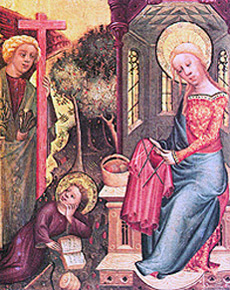
Knitting Madonna from Visit of the Angel by Master Bertram of Minden, 14th century (Crowfoot, p.56).
Wool quality/sheep species
1000 years ago the species of sheep was different from nowadays. In Finland they had Åland sheep and Kainuu-sheep that was another ancient-medieval type that resembled the ancient or medieval type of sheep here in Finland. The yarn, which is spun from these breeds is much harder and often has hairs hanging from the yarn. A product made from yarn like this is more coarse, shiny, tight and feels different than a product which is made from yarn made from modern wool yarn. (Krista Vajanto, telephone conversation, 8.2.2003)
Ancient 'coastal species´wool did not felt properly and the wool qualities in the back and stomach are different (Vajanto, p. 33). The underwool was fine and soft also on the ancient species of sheep. It was separated from the other wool and used for finer work. This yarn is very hairy and hard: it abraded the skin on my hands.
I have also included samples from both ancient Finnish and modern sheep wool for people to compare. Wool and wool yarn from ancient Finnish species of sheep are available from Kurala, Kylämäki from the Turku University historical farm since the 1960's, but the products they sell are occasionally mixed yarn from modern and ancient sheep (Vajanto, telephone con. 8.2.2003). That information is not included: when you buy these special yarns you have to be sure and ask! I was lucky and bought my yarn earlier when they did not yet mix it yet. Also nowadays the wool yarn is mostly heavy and thick and therefore not suited to fine works such as those in the ancient Finnish grave finds.
Needles
The finds of nålebinding needles in Finland include those from the late Iron Age of Eura and Kärsämäki in Maaria as well as other periods. The Eura needle was made from bronze. Roman Iron Age finds of metallic needles have also been made (Kaukonen, Kinnasompelu, p. 54). From Hald's book the information says that also wooden and bone needles may have used, and from Finland there are those that have survived from 19th century. Those would not last a thousand year in the graves. Finnish soil is very acidic which explains why we don’t have any surviving from the Viking or Medieval periods.
I use needles, which my husband makes from lamb leg bones. These are very practical and suit well to the classical idea: you should use everything from your kill. People were thrifty in ancient times: they used everything they could.

Making of the mittens: a design problem
Because very little is left in the ground, I based the outlook and form of the mittens to examples found from folklore. We have many whole mittens surviving from the 19th century in Finland, and they all were flat from the top, unlike in Sweden, where the folklore mittens are round from the top (Nordland). In Viking and medieval times also Scandinavian mittens were flat from the top, for example medieval finds from Lund, Copenhagen and Riga (Vajanto, p. 42). Therefore I have made all these mittens flat from the top.
Also, considering the length of the mitten, I could not base it on ancient material, because in those two finds from Tuukkala, Mikkeli where the leftover pieces are from the arm hem, no top is left. The form of the armhole, straight or widening towards the armhole; both ways have ancient examples: mittens from Lund and Riga are straight, the late period Åsle mitten widening towards the arm end. (Vajanto, p. 43). So I made the length and arm end design of the mittens just to please myself.
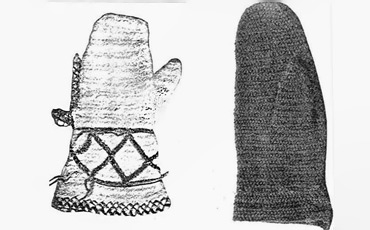
Mittens from 19th century Finland (Vahter's article)
When making nålebinding you take a suitable length of yarn and put it into the needle-eye. When you have made it and it is time to take another, you have to end the yarn somehow. I have found out that the best way to do so is to sew two loops with both the old and new yarn. It is very quick if you have two needles in use. In a thick and heavy material it does not work, though, as it is seen in Tuukkala mitten 2. Here the yarn-to-change-parts are clearly visible and do not look nice. In some mittens I have tried to end the yarn ends afterwards with a needle from the reverse side and that seems to go better wth thicker yarns. I have told that the ends of both the old and new yarn pices should be opened and mixed together; I have tried it but that method did not suit me well. I believe that every worker had their own way to deal with the yarn ends, depending of her personal please and the project, which was at hand at the moment.
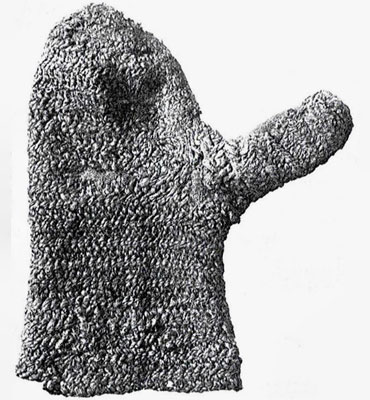
Mitten from medieval Lund (Hald)
My work
I have made nålebinding mittens based on finds from different cemeteries from different areas and time periods (Viking-Medieval) among the Finnish archaeological finds.
The Eura mitten
From the cemetery of Luistari in Eura, west coast Finland, one female grave was found with rich jewels and a lot of textile pieces. The grave was dated to 1025-1050 AD, based on one of the coins hanging from the woman's necklace. The textiles of this grave 56 were analyzed carefully in early 1990's, and the reconstruction based to this information was declared as one of our national dresses, but the nålebinding pieces were not among them and were not included to the dress reconstruction. Of those six pieces (biggest KM 18000:1702, size 6x9 cm) survived, the biggest was partly above the knife scabbard and partly above its hanger from the waist belt. Based to this information it is commonly accepted that the pieces were from mitten.

Mitten from Eura
This is the mitten I made. Reds and yellow yarns are z-spun s-plied, both being 2 millimeters in thickness. Blue yarn was strongly s-spun, unpiled, being about 1 millimeter by thickness. The sewing is made using two blues aside, unpiled (Vajanto, p. 31) There is 1,5 centimeter of red yarn between the yellow and blue lines; Mrs. Vajanto supposes that to be a beginning of a thumb. There is only a small amount of it left, so it is impossible to be sure if the rest of the thumb has been one-color-red or lined with yellow and red. (Vajanto, p.34)
The hand part, from the thumb up, is made using lines of yellow and red Z-spun S-plied yarns, the same way which the wool yarn sold in stores nowadays is. Mrs. Krista Vajanto has investigated them and found out that the loop line height was 1.2 cm and there were 5 loops per centimeter. (Telephone conversation in 8.2.2003). The lines are attached together using two loops from the previous line (F2). She says that it is most likely that the method of looping was using two loops in the thumb, being in Egon Hansen's language: UUOO/UUOOO (NESAT III). The thumb is red and the arm is made from two blue unpiled S-spun yarns together. The blue arm and the red thumb to be attached to previous line differently from the hand part: probably using only one loop from the previous line (F1) or B1+F1. (E-mail consultation from Krista Vajanto on 10.1.2003).
The red and yellow yarns I use here were hand-dyed by Krista Vajanto. Mrs. Vajanto was not allowed to send any of the nålebinding pieces, which are stored in the cellar of National Museum of Finland, to York to be color-analyzed, so there is no 20th century proof for this grave find to these colors. She thinks that the colors of the yarns are tannins from barks of alder and willow, but she used the red from madder (Rubia tinctoria L.) instead. It should maybe have been spiced with a punch of Parmelia saxatilis which together could perform a typical red color used in the costumes of Eura area (Vajanto, p.49), the yellow color from many plants (many plants in Finnish nature produce yellow). (Here Mrs. Vajanto has used heather (Calluna vulgaris)) and the blue color from imported indigo (Indigofera tinctoria) (call, 8.2.2002). I have heard about new color analyses from Jaana Riikonen who investigated the cemetery of Kaarina, Kirkkomäki (symposium 2.2.2002). She sent some red textile pieces to York to be analyzed with a new system. The result was that the red was from the plant which grows on the stones (Parmalia saxatilis L.), not madder which is thought to be the most common source of red color in the Viking Age.
S-spun blues are a leftover from a special order for weaving the male Viking Finnish cloak, the model in the grave 308 in the Luistari cemetery, Eura in west coat Finland, the same cemetery where this woman's grave was located. I have checked the thickness of the yarns with Krista Vajanto; she thinks that the thickness and the way of spinning and plying them is alike the ones in the grave.
The result was interesting: the mittens have three colors and also there are two different attaching-methods used in the one mitten; also different yarns used in one work. The structure used in arm is interesting: because attached from only one loop from previous line the 'knit' result is very stretching, which suits well to the arm part of the mitten.
Tuukkala mitten 1
From the Tuukkala cemetery at Mikkeli there were found from male grave, dated to 1200-1300 AD, a thick mitten piece (KM 9770:4) which was nålebinded from thick s-spun Z-plied yarn of white or very light color. The thickness of its yarn was 1,4-2,4 millimeters. It was made two loops on the thumb, in Hansen's language UUOO/UUOOO. From the previous line was taken two loops. (Vajanto, p. 27)
My reconstruction of Tuukkala mitten 1. © Satu Hovi 2005. I had some yarn bought from Estonia left; it is a bit coarse and tight. I put it into water with madder, but due to the yarn quality the color did not stay, but in to this nålebinding piece, which is supposed to be light color, it suits perfectly. Krista Vajanto has mentioned to me that nowadays it is difficult or even impossible to see whether one was white or any light color one thousand years ago.
There is a big leftover piece from the mitten (supposed-to-be) back. There are some traces from one color embroidery. The yarn used in it was s-spun, thickness 0,8-1 millimeter. The embroidery was made with loopstich and crosstich. It was green, blue or brown in color. (Vajanto, p. 27) From the photos taken by Krista Vajanto from the piece stored in the cellar of Finnish National Museum in Helsinki those leftover yarns are easily distinguishable. Also Tyyni Vahter has made a small size drawing of the embroidery 50 years ago, when there probably were more yarn visible than nowadays.

Copyright Satu Hovi 2005.
Using information from both sources I made a drawing of the leftover embroidery. I also made some sketches to fit the picture to a hand back of a male's mitten. From my sketches I chose the one which pleased me most. I had two main thoughts where to start sketching. First was to look after Wiking symbols. Lady Bertrade Deslipins (pseud.), who has a talent to give new ideas over things, suggested the tree of life, which would fit well to mittens packed with a dead person during his/her burial. My idea was to search after Byzantine patterned silks and find the forms there: if an ancient lady saw some expensive silks on the market and liked the pattern, she went home and redrew it as well as she could remember to an embroidery on a mitten.
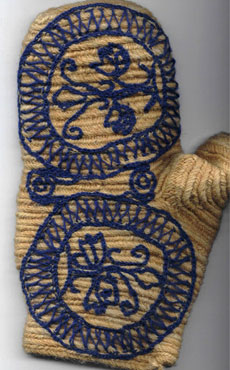
Tuukkala mitten 2
My reconstruction from Tuukkala mitten 2. © Satu Hovi 2005. From the Tuukkala cemetery in Mikkeli there is a piece of nålebinding, too (KM 9969:14). The grave was dated to 13th century and it was a female grave. This mitten is made from s-spun unpiled yarn, thickness around 1,3-1,5 millimeters, color white or light, maybe yellow. The knitting method of it was complicated; it was sewn using four loops in a thumb. In Hansen's language it means UUUOO/UUOOOO. From the previous line it was taken two loops. The mitten was felted before the arm end was embroidered. The mitten has two-color, probably blue and red, embroidery in the arm end.of the mitten. Yarns are z-spun, thickness 0,4-0,7 millimeters. They look sharp and shiny like being made yesterday. (Vajanto, p. 27 and meeting 17.4.2003)

Kaukola mitten
From woman's grave 1 from the Kekomäki cemetery in Kaukola, eastern Finland was found a fine piece of nålebinding (KM 2489:49). The grave was dated around 1200 AD. Vahter and Kaukonen, who both write about it, claim that it is possibly a sock, which they base on the Finnish 19th century folklore finds, where this kind of looping were used in sock arms. Krista Vajanto and Pirkko-Liisa Lehtosalo-Hilander both think it is a mitten, because of the location of the piece in the grave.(conversation). The piece was found from the waist, over upper apron part, where normally mittens are located in the grave finds. Aprons were hung double around the belt in the waist in women's dress of those times. The thickness of the yarn of every color is 0,9-1,1 mm, s-spun z-plied (Vajanto, p.27). Though I have done some spinning, I could not imagine doing yarn this thin, when it is plied it is 1 mm thick, while unpiled…. According to Mrs. Vajanto the yarn I have chosen is similar to the one in the grave find, being alike in the amount of plies per centimeter and strength (meeting, 17.3.2003).

This picture shows the technique of the Kaukola mitten made from thick yarn (from Kaukonen's article). The original mitten is three colored: white or yellow, red or brown and blue, one line in each color. It is made using a method where two loops are in a finger, (Vajanto, 8.2.2003, Kaukonen, kinnasompelu…). In Hansen's language it means UOO/UUOO. From the previous line is not taken one loop from the top, it is taken one from the middle of the previous loop line, from the converse direction than it normally were taken. That makes the lines to be very low and gives a wavelike look.
It was very slow work to make this product. Because the yarn is so thin, I could not work with my usual bone needle; I had to use a thin metallic one. In ancient times they could make thinner needles for this purpose. A thick bone needle left the loops too loose. I could use my thumb while sewing this. It gave a stabile result and was faster than using a stick instead of my thumb. An extra tightening was needed before forming a new loop, though.
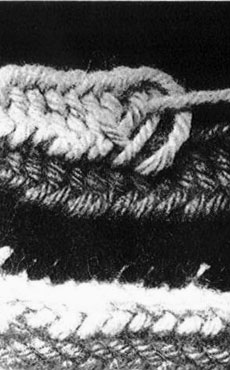
Masku and Perniö - mittens
From Masku in the cemetery of Humikkala, grave 30, a female grave from the half of the 11th century, a nålebinding find was made (NM 8656 H 30). This was supposedly a piece of a mitten which was made from thin white (or light) Z-spun unpiled yarn, which was made using two yarns together. The looping method is probably UUOO/UUOOO. The yarns were about 0,6 mm thick, together about 1,1-1,5 millimeter. (Vajanto, p.27) Similarly two yarns were used aside when sewing the mitten based to the finds from the cemetery of Yliskylä in Perniö there were found from female grave number 6 a piece of mitten (KM 2912:95) made from white, z-spun unpiled yarn. Two yarns were used together when sewn. The method was likely two loops on the thumb (Vajanto, p.27). The grave was dated to the beginning of 12th century (Tomanterä, p.118).
Both of these pieces are very small, about 2 square centimeters, and my work is based on those pieces.
I have made my mittens from yarn I bought from Pirtin kehräämö, 180 TEX x 1, natural white. I used two yarns as a one. The same yarn is also recommended when weaving a replica of the Eura apron, which is then dyed (Euran puvun työohjeet).
Other mittens in Finnish grave finds
Another find from Köyliö, cemetery of Vanhakartano, female grave 28 dated to the middle of the 11th century was a nålebinding (KM 8723:315) made from white Z-spun S-plied yarn and made in a typical Finnish way with two or more loops in the thumb (Tomanterä, p.118). Also in Köyliö, cemetery of Köyliönsaari, a nålebinding (KM 723:308) which was made of white z-spun s-plied yarn, made with two loops in the thumb. (Vajanto, p.24 and 27) was found from a female grave which was dated to 11th century.
A nålebinding find (KM 12687) found from a female grave in Kirkkomäki in Kaarina and dated to 11th century is too small to be identified, being less than 1 square centimeters in size (Tomanterä, p.118). It was z-spun s-plied and made using two loops in a thumb, in Hansens method UUOO/UUOOO.(Vajanto, p.28) The piece found from Rikala in Halikko, male grave Fa, dated to the 12th century, (KM 12841:29), was made with white Z-spun S-plied yarn made in the technique with two or more loops in the thumb (Tomanterä, p. 119), in Hansens language UUOO/UUOOO
Felted nålebinded mitten I made. I used a yarn that is 50% dog hair. Hair was mixed with wool in ancient times.From the same cemetery in Rikala in Halikko another piece of nålebinding was found (KM 12690:475. It is reddish brown, probably felted from both sides. (Vajanto, p.28) The structure is not visible, but horizontal lines can be seen, which are typical for nålebinding (Tomanterä, p.118). The are also other nålebinding finds from Finland (Tomanterä, p.118, Krista Vajanto, 8.2.2003), but they are unidentified and/or unpublished.
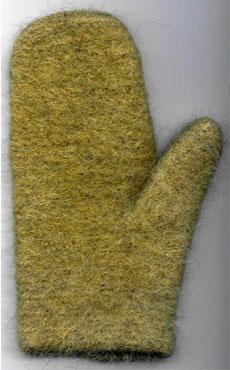
Conclusion
Through this study I have learned a lot about ancient nålebinding constructions. I have learned that a medieval Finnish woman knew different nålebinding variations. She could choose among them the one which she thought would fit to her purposes in different products. I have learned that a medieval woman could use all the leftover yarns from winter session weaving to make nålebinding mittens of various thicknesses. I have learned that she could well please her need of beauty by making colorful products and by decorating them nicely.
Bibliography
Published
Appelgren-Kivalo: Suomalaisia pukuja myöhemmältä rautakaudelta. 1905.
Crowfoot, Pritchard & Staniland: Textiles and clothing 1150-1450. Medieval finds from excavations of London 4. 2001
Gutarp: Hurusom man sig klädde. En bok om medeltida dräkt. 1990
Hald: Ancient Danish textiles. 1980.
Hansen, Egon: Nålebinding: definition and description. In: Textiles in Northern Archaeology. NESAT III Textile Symposium in York. 1990.
Kaukonen: Puikoilla kutomisen historiaa Suomessa. Osasivatko Naantalin luostarin nunnat kutoa puikoilla? Kotiteollisuus 1984/5.
" Kinnasompelun levinneisyys ja työtavat Suomessa. Suomen museo 67. Helsinki 1960.
Lehtosalo-Hilander: Euran esihistoria. Vammala, 2000.
" Euran puku ja muut muinaisvaatteet, Vammala 2001.
" Luistari I. The Graves. Suomen muinaismuistoyhdistys 1982.
Nockert & Possnert: Att datera textilier. Gridlunds förlag, 2002.
Norrland: Primitive Scandinavian textiles in knotless netting. Studia Norvegica 10. Oslo University Press, 1961.
Tomanterä: Nadelhandschuhe aus der jungeren Eisenzeit in Finnland. Fennoscandia archaeologica IV. Helsinki 1987.
Vahter, Tyyni: Tuukkalan neulakinnas. SMYA XL (1934)
Vajanto, Krista: Euran emännän neulakintaat. Tutkielma Luistarin haudan 56 neulakinnasfragmenteista. Pro-gradututkielma, arkeologian oppiaine, Helsingin yliopisto, 2003 http://www.vajanto.net/gradu/
Unpublished material
Vadén, Mari: Katsaus Turun maakuntamuseon keskiaikaisiin tekstiileihin vuoteen 1992 saakka. Arkeologian proseminaariesitelmä. Turun yliopisto. 2002
Valtonen, Erja (now called Erja Kaarina Helkiö): Euran puvun työohjeet.
Other
Ancient dress symposium on 2.2.2002. Helsinki, Adult Education Center.
Vajanto, Krista: email and telephone conversations 10.1.2003, 20.2.2003, meeting 8.2.2003, 17.4.2003 and 3.4.2003.